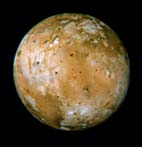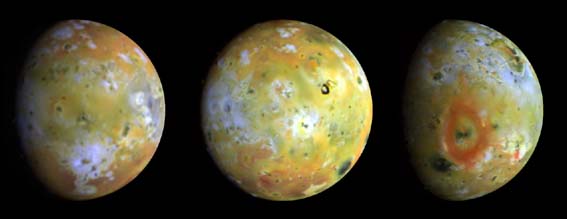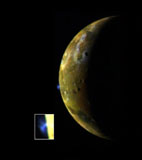
J. Brit. Astron. Assoc., 106, 5, 1996 (pp 242–243)

Figure 1. Compiled by Simon Mentha from 1979 Voyager images, this image is of the same face of Io as the left-hand Galileo image in Figure 2. Several changes due to volcanic eruptions are evident in the latter. The major ones are: i) The appearance of the very dark caldera with a white halo, just left of centre; this was a pale feature in the Voyager image. ii) The bright white areas near the right-hand limb are more prominent, and surrounded by a large grey halo which has masked some of the earlier features. iii) Details have changed near the eruptive volcano Masubi, which is a dark spot in the extensive white area near the bottom.

Figure 2. Three full-disk views of Io in enhanced colour (near-infrared-, green-, and violet-filtered). The major red areas shown here appear to be closely associated with very recent fragmental volcanic deposits (pyroclastics) erupted in the form of volcanic plumes. The most prominent red oval surrounds the volcano Pele (right-hand image). An intense red spot lies near the active plume Marduk east of Pele. Other reddish areas are associated with known hot spots or regions that have changed substantially since the Voyager spacecraft flybys of 1979. The reddish deposits may be the products of high-temperature explosive volcanism. Several volcanic plumes active during the Voyager flybys in 1979 occurred near the bright limbs or terminator regions of these images, where airborne materials should be detectable. Loki and Amirani appear to be inactive, Volund is active, and Pele may be active but is extremely faint. The plume Marduk also seems to be active, and dark jets of erupting materials can be seen against the disk. Several previously unknown mountains can be seen near the terminators.
Near the centre of the middle image is the active volcano Ra. In the Voyager images it was inactive but was surrounded by many radiating lava flows. Between 1994 and 1995, HST pictures showed a large bright white patch developed at this site. This Galileo image shows this patch to be deposits from Ra, masking the earlier lava flows, and with yellow and dark grey deposits superimposed around the caldera. The complex black spot towards upper right is Loki, the most consistently energetic volcano on Io over the last 17 years, but uncharacteristically quiet during the Galileo imaging. What is most surprising is how little it has changed since Voyager.

Figure 3. This image shows Ra on the limb, with a blue eruptive plume extending about 100km into space above it. NASA says: 'The blue colour is consistent with the presence of sulphur dioxide gas and 'snow' condensing from the gas as the plume expands and cools. Galileo images have also shown that the Ra Patera plume glows in the dark, perhaps due to the fluorescence of sulphur and oxygen ions created by the breaking apart of sulphur dioxide molecules by energetic particles in the Jovian magnetosphere.'
Back to top of page
Return to Journal 1996 October contents page